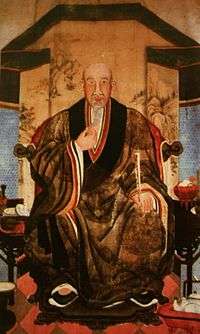Silk painting

Silk painting refers to paintings on silk. They are a traditional way of painting in Asia.
National styles
China
One of the earliest surviving Chinese silk paintings is a 2-metre long T-shaped painting, dated around 165 BCE, from the Mawangdui.[1][2] Though painting on silk quickly gave way to painting on other forms.
The technique. Silk painting uses gutta as a resist,meaning that fancy patterns can be achieved.
Tibet
The Tibetan Thangka is the best known religious painting.
Vietnam
Ancient period

Silk painting (Tranh lụa) was a traditional artisanry in Vietnam. There has been some old silk paintings, e.g. portraits of Nguyễn Trãi, Phùng Khắc Khoan, Trịnh Đình Kiên, Phan Huy Cẩn, Phan Huy Ích, Phan Huy Thực, Phan Huy Vịnh dated from Lê and Nguyễn dynasty.[3]
Modern period
Silk paintings of modern period in Vietnam were taken up by some of the students and French teachers at the EBAI in Hanoi during the 1930s.[4] The earliest representative of the new interest in silk painting was the 1931 Paris exhibition of the silk paintings of Nguyễn Phan Chánh, a student of EBAI who had originally trained in calligraphy, who struggled with French oil techniques, and whom the school director Victor Tardieu encouraged to use traditional media.[5]
References
- ↑ The art of Chinese painting - Page 17 2006 "Another important silk painting was unearthed from the Mawangdui Han tombs near Chanshan. It is estimated to belong to the period around 165 BC. The painting is in a T-shape. Archaeologists call it "non-dress" painting as it looks like a dress but ..."
- ↑ The legend of Mawangdui - Page 57 Dongxia Zhang - 2007 "This huge, 2-meter-long, intact silk painting was the first discovery of its kind in Chinese archaeological history. "
- ↑ Painter Phan Cẩm Thượng (2010-09-27). "Tranh lụa từ truyền thống đến hiện đại". Thông tin Thể thao Văn hóa. Retrieved 2015-12-14.
- ↑ Painters in Hanoi: an ethnography of Vietnamese art - Page 35 Nora A. Taylor - 2009 "Thus, the myth that silk painting was "discovered" by teachers and students at the EBAI is perpetuated because ... Unlike lacquer, silk painting was never considered at the EBAI a craft, but it was categorized as an indigenous form of artisanry."
- ↑ Caroline Turner Tradition and change: contemporary art of Asia and the Pacific - 1993 "Tardieu also encouraged experimentation with such traditional media as lacquer and silk. Although a poor student in anatomy and oil, Nguyen Phan Chanh (1892-1984) excelled in silk. In 1931 , he exhibited his first silk paintings in Paris ."